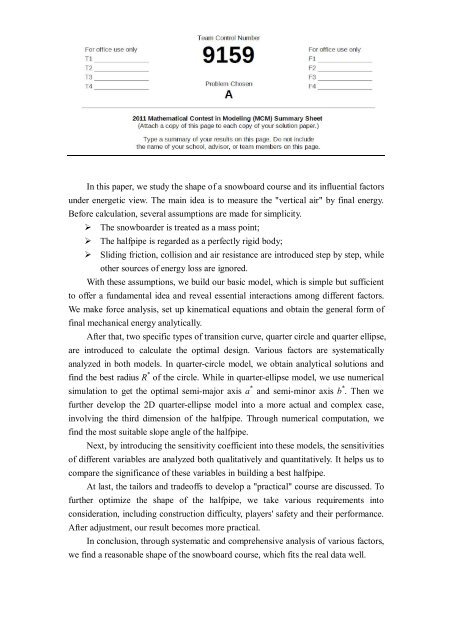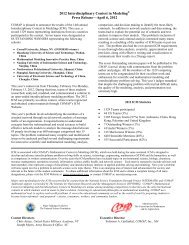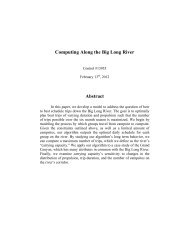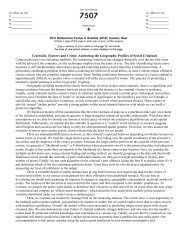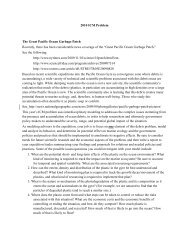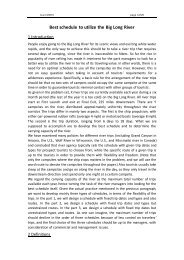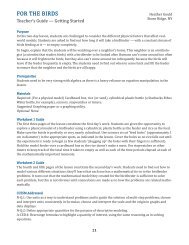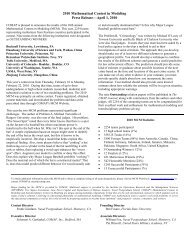Team 9159: Higher in the Air: Design of Snowboard Course
Team 9159: Higher in the Air: Design of Snowboard Course
Team 9159: Higher in the Air: Design of Snowboard Course
You also want an ePaper? Increase the reach of your titles
YUMPU automatically turns print PDFs into web optimized ePapers that Google loves.
In this paper, we study <strong>the</strong> shape <strong>of</strong> a snowboard course and its <strong>in</strong>fluential factors<br />
under energetic view. The ma<strong>in</strong> idea is to measure <strong>the</strong> "vertical air" by f<strong>in</strong>al energy.<br />
Before calculation, several assumptions are made for simplicity.<br />
‣ The snowboarder is treated as a mass po<strong>in</strong>t;<br />
‣ The halfpipe is regarded as a perfectly rigid body;<br />
‣ Slid<strong>in</strong>g friction, collision and air resistance are <strong>in</strong>troduced step by step, while<br />
o<strong>the</strong>r sources <strong>of</strong> energy loss are ignored.<br />
With <strong>the</strong>se assumptions, we build our basic model, which is simple but sufficient<br />
to <strong>of</strong>fer a fundamental idea and reveal essential <strong>in</strong>teractions among different factors.<br />
We make force analysis, set up k<strong>in</strong>ematical equations and obta<strong>in</strong> <strong>the</strong> general form <strong>of</strong><br />
f<strong>in</strong>al mechanical energy analytically.<br />
After that, two specific types <strong>of</strong> transition curve, quarter circle and quarter ellipse,<br />
are <strong>in</strong>troduced to calculate <strong>the</strong> optimal design. Various factors are systematically<br />
analyzed <strong>in</strong> both models. In quarter-circle model, we obta<strong>in</strong> analytical solutions and<br />
f<strong>in</strong>d <strong>the</strong> best radius R * <strong>of</strong> <strong>the</strong> circle. While <strong>in</strong> quarter-ellipse model, we use numerical<br />
simulation to get <strong>the</strong> optimal semi-major axis a * and semi-m<strong>in</strong>or axis b * . Then we<br />
fur<strong>the</strong>r develop <strong>the</strong> 2D quarter-ellipse model <strong>in</strong>to a more actual and complex case,<br />
<strong>in</strong>volv<strong>in</strong>g <strong>the</strong> third dimension <strong>of</strong> <strong>the</strong> halfpipe. Through numerical computation, we<br />
f<strong>in</strong>d <strong>the</strong> most suitable slope angle <strong>of</strong> <strong>the</strong> halfpipe.<br />
Next, by <strong>in</strong>troduc<strong>in</strong>g <strong>the</strong> sensitivity coefficient <strong>in</strong>to <strong>the</strong>se models, <strong>the</strong> sensitivities<br />
<strong>of</strong> different variables are analyzed both qualitatively and quantitatively. It helps us to<br />
compare <strong>the</strong> significance <strong>of</strong> <strong>the</strong>se variables <strong>in</strong> build<strong>in</strong>g a best halfpipe.<br />
At last, <strong>the</strong> tailors and trade<strong>of</strong>fs to develop a "practical" course are discussed. To<br />
fur<strong>the</strong>r optimize <strong>the</strong> shape <strong>of</strong> <strong>the</strong> halfpipe, we take various requirements <strong>in</strong>to<br />
consideration, <strong>in</strong>clud<strong>in</strong>g construction difficulty, players' safety and <strong>the</strong>ir performance.<br />
After adjustment, our result becomes more practical.<br />
In conclusion, through systematic and comprehensive analysis <strong>of</strong> various factors,<br />
we f<strong>in</strong>d a reasonable shape <strong>of</strong> <strong>the</strong> snowboard course, which fits <strong>the</strong> real data well.
<strong>Higher</strong> <strong>in</strong> <strong>the</strong> <strong>Air</strong>:<br />
<strong>Design</strong> <strong>of</strong> <strong>Snowboard</strong> <strong>Course</strong><br />
<strong>Team</strong> # <strong>9159</strong><br />
February 15, 2011<br />
1
Contents<br />
1 Introduction ........................................................................ 4<br />
2 Symbols, Hypo<strong>the</strong>sis and Explanations ............................... 5<br />
2.1 Symbols Used <strong>in</strong> this Paper.................................................. 5<br />
2.2 Hypo<strong>the</strong>sis ....................................................................... 5<br />
2.3 Some Explanations............................................................. 6<br />
3 Basic Model ........................................................................ 7<br />
4 Application <strong>in</strong> 2D Case ....................................................... 9<br />
4.1 Quarter-Circle Type ........................................................... 9<br />
4.2 Quarter Ellipse Type .......................................................... 11<br />
4.2.1 Snow Friction Only . . . . . . . . . . . . . . . . . . . . . . . 12<br />
4.2.2 Snow Friction and Collision . . . . . . . . . . . . . . . . . . 13<br />
4.2.3 Snow Friction, <strong>Air</strong> Friction and Collision . . . . . . . . . . . 13<br />
4.3 Sensitivity ........................................................................ 14<br />
5 Application <strong>in</strong> 3D Case ....................................................... 16<br />
6 Tailors and Trade<strong>of</strong>fs........................................................... 18<br />
6.1 Safety Analysis.................................................................. 19<br />
6.2 The Construction............................................................... 19<br />
6.3 The Twist ........................................................................ 19<br />
7 Strengths and Weaknesses................................................... 20<br />
7.1 Strengths ......................................................................... 20<br />
7.2 Weaknesses....................................................................... 20<br />
8 Conclusion .......................................................................... 21
List <strong>of</strong> Figures<br />
1 <strong>Snowboard</strong> competetion[1] . . . . . . . . . . . . . . . . . . . . . . . 4<br />
2 Cross section <strong>of</strong> <strong>the</strong> halfpipe, perpendicular to <strong>the</strong> ground . . . . . 5<br />
3 R ∗ -w curve . . . . . . . . . . . . . . . . . . . . . . . . . . . . . . . 11<br />
4 R ∗ -µ curve . . . . . . . . . . . . . . . . . . . . . . . . . . . . . . . . 11<br />
5 R ∗ -h i curve . . . . . . . . . . . . . . . . . . . . . . . . . . . . . . . 11<br />
6 R ∗ -x 0 curve . . . . . . . . . . . . . . . . . . . . . . . . . . . . . . . 11<br />
7 Left: E t -a curve under different b; Right: E t -b curve under different<br />
a. Only <strong>the</strong> snow friction is considered . . . . . . . . . . . . . . . . 12<br />
8 Left: E t -a curve under different b; Right: E t -b curve under different<br />
a. The snow friction and collision are considered . . . . . . . . . . . 13<br />
9 Left: E t -a curve under different b; Right: E t -b curve under different<br />
a. The snow friction, w<strong>in</strong>d friction and collision are considered . . . 14<br />
10 a ∗ -x 0 curve . . . . . . . . . . . . . . . . . . . . . . . . . . . . . . . 15<br />
11 a ∗ -h i curve . . . . . . . . . . . . . . . . . . . . . . . . . . . . . . . . 15<br />
12 a ∗ -α curve . . . . . . . . . . . . . . . . . . . . . . . . . . . . . . . . 15<br />
13 a ∗ -h 0 curve . . . . . . . . . . . . . . . . . . . . . . . . . . . . . . . 16<br />
14 a ∗ -µ curve . . . . . . . . . . . . . . . . . . . . . . . . . . . . . . . . 16<br />
15 a ∗ -E i curve . . . . . . . . . . . . . . . . . . . . . . . . . . . . . . . 16<br />
16 3D halfpipe . . . . . . . . . . . . . . . . . . . . . . . . . . . . . . . 16<br />
17 Left: E t -a curve under different b; Right: E t -b curve under different<br />
a. The snow friction and collision are considered . . . . . . . . . . . 17<br />
18 Left: E t -a curve under different b; Right: E t -b curve under different<br />
a. The snow friction and collision are considered . . . . . . . . . . . 18<br />
19 Left: E t -a curve under different b; Right: E t -b curve under different<br />
a. The snow friction and collision are considered . . . . . . . . . . . 18<br />
3
<strong>Team</strong> # <strong>9159</strong> page4 <strong>of</strong> 22<br />
1 Introduction<br />
<strong>Snowboard</strong><strong>in</strong>g is an adventurous and excit<strong>in</strong>g<br />
sport that has been contested at <strong>the</strong><br />
W<strong>in</strong>ter Olympic Games s<strong>in</strong>ce 1998.<br />
Till<br />
now, <strong>the</strong> events are held <strong>in</strong> three specialities:<br />
parallel giant slalom, snowboard cross<br />
and halfpipe.[2] What we are <strong>in</strong>terested here<br />
is <strong>the</strong> halfpipe, <strong>in</strong> which competitors perform<br />
tricks while go<strong>in</strong>g from one side <strong>of</strong> a ditch to<br />
<strong>the</strong> o<strong>the</strong>r.<br />
For both ornamental and safety<br />
Fig 1: <strong>Snowboard</strong> competetion[1]<br />
purpose, <strong>the</strong> shape <strong>of</strong> <strong>the</strong> halfpipe is <strong>of</strong> vital importance.<br />
In its most basic form, a halfpipe consists <strong>of</strong> two concave ramps (or quarterpipes),<br />
topped by cop<strong>in</strong>gs and decks, fac<strong>in</strong>g each o<strong>the</strong>r across a transition and an<br />
extended flat ground (<strong>the</strong> flat bottom) added between <strong>the</strong> quarterpipes. For snowboard<strong>in</strong>g,<br />
<strong>the</strong> plane <strong>of</strong> <strong>the</strong> transition is oriented downhill at a slight grade to allow<br />
riders to use gravity to develop speed and facilitate dra<strong>in</strong>age <strong>of</strong> melt.<br />
There are three ma<strong>in</strong> tasks <strong>in</strong> this paper as follows:<br />
• Determ<strong>in</strong>e <strong>the</strong> shape <strong>of</strong> a snowboard course which can generate <strong>the</strong> highest<br />
jump above <strong>the</strong> edge <strong>of</strong> <strong>the</strong> halfpipe.<br />
• Optimize <strong>the</strong> shape to satisfy o<strong>the</strong>r requirements <strong>of</strong> <strong>the</strong> tricks.<br />
• In practical, what properties <strong>of</strong> <strong>the</strong> halfpipe should be abandoned.<br />
We analyze <strong>the</strong> problem from <strong>the</strong> viewpo<strong>in</strong>t <strong>of</strong> energy translation. The competition<br />
between <strong>the</strong> <strong>in</strong>flux from gravitational potential energy and <strong>the</strong> loss caused<br />
by friction and collision determ<strong>in</strong>es <strong>the</strong> process <strong>of</strong> slid<strong>in</strong>g. To study <strong>the</strong> energy<br />
change <strong>in</strong> this process, we firstly consider about <strong>the</strong> 2D case. We build a simple<br />
quarter circle-type model to study what factors <strong>in</strong>volve <strong>in</strong> and what role <strong>the</strong>y play.<br />
Next <strong>the</strong> slid<strong>in</strong>g process is fur<strong>the</strong>r simulated by <strong>in</strong>troduc<strong>in</strong>g an elliptic-type trail.<br />
The energy loss is calculated numerically to obta<strong>in</strong> an ideal shape for 2D trail.<br />
Then we take <strong>the</strong> third dimension <strong>in</strong>to consideration. We work out <strong>the</strong> slope angle<br />
by balanc<strong>in</strong>g <strong>the</strong> energy ga<strong>in</strong><strong>in</strong>g and los<strong>in</strong>g <strong>in</strong> new 3D model, which is developed<br />
from former 2D case.<br />
4
<strong>Team</strong> # <strong>9159</strong> page5 <strong>of</strong> 22<br />
At last, to optimize <strong>the</strong> shape <strong>of</strong> <strong>the</strong> halfpipe, we take various requirements<br />
<strong>in</strong>to consideration, <strong>in</strong>clud<strong>in</strong>g construction difficulty, players’ safety and <strong>the</strong>ir performance.<br />
2 Symbols, Hypo<strong>the</strong>sis and Explanations<br />
2.1 Symbols Used <strong>in</strong> this Paper<br />
We list <strong>the</strong> quantities we use as follows. Some are geometric parameters <strong>of</strong><br />
<strong>the</strong> halfpipe, some are physical quantities <strong>in</strong> <strong>the</strong> slid<strong>in</strong>g process. Symbols and<br />
correspond<strong>in</strong>g parameters are shown <strong>in</strong> Tab. 1 and Fig. 2.<br />
Fig 2: Cross section <strong>of</strong> <strong>the</strong> halfpipe, perpendicular to <strong>the</strong> ground<br />
2.2 Hypo<strong>the</strong>sis<br />
• We treat <strong>the</strong> snowboarder as a mass po<strong>in</strong>t with mass m, ignor<strong>in</strong>g body twists<br />
<strong>of</strong> snowboarder and o<strong>the</strong>r geometrical properties.<br />
• The mass po<strong>in</strong>t moves right on <strong>the</strong> snowboard course ra<strong>the</strong>r than travel<strong>in</strong>g<br />
along <strong>the</strong> trajectory <strong>of</strong> <strong>the</strong> orig<strong>in</strong>al gravity center <strong>of</strong> a snowboarder above <strong>the</strong><br />
snow surface.<br />
5
<strong>Team</strong> # <strong>9159</strong> page6 <strong>of</strong> 22<br />
Symbol<br />
Quantity<br />
m<br />
Mass <strong>of</strong> snowboarder and <strong>the</strong> snowboard<br />
µ Friction coefficient between snow and <strong>the</strong> board<br />
N Pressure on <strong>the</strong> snow surface caused by snowboarder<br />
E<br />
Total mechanical energy <strong>of</strong> <strong>the</strong> snowboarder<br />
h 0<br />
x 0<br />
h i & E i<br />
W & w<br />
L<br />
The height <strong>of</strong> <strong>the</strong> halfpipe<br />
Horizontal distance between <strong>the</strong> land<strong>in</strong>g po<strong>in</strong>t and <strong>the</strong> cop<strong>in</strong>g<br />
Initial height & energy <strong>of</strong> <strong>the</strong> snowboarder<br />
Width and half width <strong>of</strong> <strong>the</strong> pipe<br />
Length <strong>of</strong> <strong>the</strong> half pipe<br />
Tab 1: Symbols used <strong>in</strong> this paper<br />
• Only collision and slid<strong>in</strong>g friction account for <strong>the</strong> mechanical energy loss,<br />
ignor<strong>in</strong>g o<strong>the</strong>r possible causes such as air friction.<br />
• The halfpipe is treated as perfectly rigid body, which can be modeled just by<br />
curve l<strong>in</strong>es.<br />
• The player does free fall<strong>in</strong>g from h i with <strong>in</strong>itial velocity 0.<br />
• We ignore <strong>the</strong> collision time and treat <strong>the</strong> collision between snowboarder and<br />
halfpipe as perfect <strong>in</strong>elastic collision.<br />
2.3 Some Explanations<br />
All <strong>the</strong> Hypo<strong>the</strong>sis above are designed for simplify<strong>in</strong>g <strong>the</strong> calculation. Qualitative<br />
analysis can be made based on <strong>the</strong>se assumptions. Because some <strong>of</strong> <strong>the</strong><br />
Hypo<strong>the</strong>sis may seem a little confus<strong>in</strong>g at <strong>the</strong> first glance, we give some explanations<br />
here.<br />
• The mass po<strong>in</strong>t is ma<strong>in</strong>ly used to simplify calculation. S<strong>in</strong>ce our aim is at first<br />
to determ<strong>in</strong>e <strong>the</strong> shape <strong>of</strong> a snowboard course to maximize <strong>the</strong> production <strong>of</strong><br />
vertical air, all <strong>the</strong> geometrical properties such as body size, shape and body<br />
twists <strong>of</strong> snowboarders can be regarded as irrelevant, at least not decisive. In<br />
fact, s<strong>in</strong>ce <strong>the</strong> body <strong>of</strong> a snowboarder is not rigid, deformation leads to an<br />
6
<strong>Team</strong> # <strong>9159</strong> page7 <strong>of</strong> 22<br />
<strong>in</strong>crease <strong>in</strong> computation complexity and <strong>the</strong> uncerta<strong>in</strong>ty <strong>in</strong> centre-<strong>of</strong>-gravity<br />
path, which covers up <strong>the</strong> essential aspects <strong>of</strong> this problem. Mass po<strong>in</strong>t<br />
assumption enables us to focus on <strong>the</strong> essential <strong>in</strong>teraction between course<br />
shape and maximum <strong>of</strong> vertical air.<br />
• In this problem, slid<strong>in</strong>g friction, <strong>in</strong>elastic collision and air friction are three<br />
ma<strong>in</strong> factors accountable for <strong>the</strong> energy loss. As for <strong>the</strong> most basic model,<br />
we just take slid<strong>in</strong>g friction and collision <strong>in</strong>to consideration for simplicity. In<br />
fur<strong>the</strong>r sections, we will <strong>in</strong>troduce air friction to give some more practical<br />
results.<br />
• Accord<strong>in</strong>g to <strong>the</strong> halfpipe standard released by International Ski Federation,<br />
<strong>in</strong> order to build a halfpipe, one should frequently drive on <strong>the</strong> decks to<br />
compact <strong>the</strong> snow before <strong>the</strong> pipe is stepped and wet new snow is preferable<br />
for construction s<strong>in</strong>ce it is easy to bond toge<strong>the</strong>r well. Therefore, <strong>the</strong> hard<br />
snow makes it feasible to assume that <strong>the</strong> halfpipe is a perfectly rigid body.<br />
3 Basic Model<br />
We use curve φ(x), 0 ≤ x ≤ W to denote <strong>the</strong> halfpipe. Accord<strong>in</strong>g to our assumption,<br />
<strong>the</strong> energy decay after land<strong>in</strong>g is due to <strong>the</strong> friction between <strong>the</strong> snowboard<br />
and <strong>the</strong> snow surfaces. Therefore, if we assume µ is a constant, <strong>the</strong>n<br />
dE = −µNds = −µN √ 1 + (φ ′ ) 2 dx. (1)<br />
N has two parts <strong>in</strong> itself, one is <strong>the</strong> part aga<strong>in</strong>st <strong>the</strong> vertical component <strong>of</strong> <strong>the</strong><br />
gravity, <strong>the</strong> o<strong>the</strong>r is centripetal force. To make force analysis, we def<strong>in</strong>e θ <strong>the</strong> angle<br />
between <strong>the</strong> velocity <strong>of</strong> snowboarder and <strong>the</strong> ground, and ρ <strong>the</strong> radius <strong>of</strong> curvature.<br />
Then k<strong>in</strong>ematical equation for <strong>the</strong> perpendicular direction is written as<br />
N = mg cos θ + mv2<br />
ρ , (2)<br />
and ρ can be calculated as<br />
1<br />
ρ = φ ′′<br />
. (3)<br />
(1 + (φ ′ ) 2 ) 3 2<br />
7
<strong>Team</strong> # <strong>9159</strong> page8 <strong>of</strong> 22<br />
Accord<strong>in</strong>g to <strong>the</strong> law <strong>of</strong> conservation <strong>of</strong> energy, <strong>the</strong> reduction <strong>in</strong> energy is equal to<br />
<strong>the</strong> energy loss caused by friction, <strong>the</strong>n<br />
E(x) = 1 2 mv2 + mgφ(x), (4)<br />
where we assume <strong>the</strong> land surface is <strong>the</strong> zero po<strong>in</strong>t <strong>of</strong> <strong>the</strong> gravitational potential<br />
energy. Substitute Eq. (2),(3),(4) <strong>in</strong>to Eq. (1), we get an ord<strong>in</strong>ary differential<br />
equation for E,<br />
d<br />
dx E + 2µφ′′<br />
2φφ′′<br />
E = −µmg[1 − ]. (5)<br />
1 + (φ ′ )<br />
2<br />
1 + (φ ′ )<br />
2<br />
To get <strong>the</strong> <strong>in</strong>itial condition for Eq. (5), notice that <strong>the</strong> collision happens at (x 0 , φ(x 0 )),<br />
where <strong>the</strong> collision angle is π 2 + θ 0. The collision is assumed perfect <strong>in</strong>elastic, that<br />
is to say <strong>the</strong> slider loses his velocity perpendicular to <strong>the</strong> snow surface. Then we<br />
have<br />
v 0 =<br />
and <strong>the</strong>n <strong>the</strong> <strong>in</strong>itial mechanical energy<br />
√<br />
2m(h − y 0 )<br />
s<strong>in</strong> θ, (6)<br />
g<br />
φ ′ (x 0 ) 2<br />
E 0 [φ] = mgy 0 + mg(h − y 0 )<br />
1 + φ ′ (x 0 ) . (7)<br />
2<br />
Solution to Eq. (5) and (7) is written as<br />
E[φ, x] = e −2µ ∫ x<br />
x 0<br />
F [φ(s)]ds [ −µmg<br />
where functional F is def<strong>in</strong>ed as<br />
∫ x<br />
x 0<br />
(1−2φ(t)F [φ(t)])e 2µ ∫ t<br />
x 0<br />
F [φ(s)]ds dt+E 0 [φ] ] , (8)<br />
F [φ(x)] =<br />
One part <strong>of</strong> Eq. (8) can be calculated analytically,<br />
∫ t<br />
φ′′ (x)<br />
1 + φ ′ (x) 2 . (9)<br />
φ ′′<br />
x 0<br />
1 + (φ ′ ) ds = arctan 2 φ′ | t − arctan φ ′ | x0 = θ(t) − θ(x 0 ). (10)<br />
Then E[φ, W ], <strong>the</strong> mechanical energy at <strong>the</strong> o<strong>the</strong>r end becomes<br />
∫ W<br />
E[φ, W ] = −µmge −2µθ(W ) (1 − 2φ(t)F [φ(t)])e 2µθ(t) dt + e −2µ[θ(W )−θ(x0)] E 0 [φ].<br />
x 0<br />
(11)<br />
8
<strong>Team</strong> # <strong>9159</strong> page9 <strong>of</strong> 22<br />
Larger E[φ, W ] means more energy before <strong>the</strong> next jump, which is what we are<br />
pursu<strong>in</strong>g.<br />
Eq. (11) provides us a fundamental way to analyze <strong>the</strong> problem. However,<br />
E[φ, W ] is a functional <strong>of</strong> φ(x), conta<strong>in</strong><strong>in</strong>g its zero, first, second derivatives and<br />
<strong>the</strong>ir <strong>in</strong>tegrals, hence a direct variational method can hardly be directly applied to<br />
it. In order to avoid a variational problem <strong>in</strong> <strong>the</strong> function space, we limit some<br />
feature <strong>of</strong> φ(x) and reduce <strong>the</strong> problem to a lower dimensional space.<br />
4 Application <strong>in</strong> 2D Case<br />
4.1 Quarter-Circle Type<br />
From a circle series expansion po<strong>in</strong>t <strong>of</strong> view, we can use a circle to simulate a<br />
curve as <strong>the</strong> first-order approximation. Thus <strong>in</strong> this issue we firstly assume <strong>the</strong> trail<br />
consists <strong>of</strong> a vertical wall, a horizontal path and a quarter circle. This is simple<br />
but can provide us much <strong>in</strong>formation about <strong>the</strong> <strong>in</strong>teractions among <strong>the</strong> relevant<br />
factors. In this case, no energy is added to <strong>the</strong> snowboarder, <strong>the</strong>refore <strong>the</strong> player<br />
may not reach <strong>the</strong> o<strong>the</strong>r edge <strong>of</strong> <strong>the</strong> course. So we only study process <strong>in</strong> (x 0 , w),<br />
where w is <strong>the</strong> midpo<strong>in</strong>t <strong>of</strong> <strong>the</strong> path. Our goal here is to analyze how <strong>the</strong> related<br />
factors, µ, h i , x 0 and w, <strong>in</strong>fluence <strong>the</strong> energy loss.<br />
Notice that on <strong>the</strong> quarter circle, we have<br />
F [φ(x)] =<br />
φ′′ (x)<br />
1 + φ ′ (x) 2 = 1<br />
R − y , (12)<br />
where R is <strong>the</strong> radius. Then accord<strong>in</strong>g to Eq. (11), we have<br />
where<br />
E(w) = e −2µθ(x0) E(x 0 ) − µmg(w − R) − mgR(1 − e −2µθ(x0) )<br />
−<br />
3µmg<br />
1 + 4µ [2µR − (x 2 0 − R + 2µ(R − y 0 ))e −2µθ(x0) ], (13)<br />
θ(x) = − arcs<strong>in</strong>(1 − x ). (14)<br />
R<br />
Eq. (13) is a useful result to analyze <strong>the</strong> effect <strong>of</strong> w, x 0 , h i , and µ. We calculate<br />
<strong>the</strong> energy E(w) for different radius to search for <strong>the</strong> best R, which we denote<br />
as R ∗ . For most parameters, E(R) has a maximum <strong>in</strong>side <strong>the</strong> <strong>in</strong>terval [x 0 , W ],<br />
which is chosen as <strong>the</strong> R ∗ . What we are <strong>in</strong>terested here is <strong>the</strong> relationship between<br />
9
<strong>Team</strong> # <strong>9159</strong> page10 <strong>of</strong> 22<br />
R ∗ and (W, h i , x 0 , µ). Accord<strong>in</strong>g to <strong>the</strong> halfpipe standard set by International Ski<br />
Federation [3], w is around 8.5m∼ 9m for 18 FT pipe and 9.5m∼ 10m for 22<br />
FT pipe. x 0 and h i is related to <strong>the</strong> trick and <strong>the</strong> slider himself. µ is related to<br />
<strong>the</strong> quality <strong>of</strong> <strong>the</strong> snow, <strong>the</strong> temperature and <strong>the</strong> <strong>in</strong>tensity <strong>of</strong> pressure between<br />
<strong>the</strong> board and snow. Usually, this value is between 0.08 and 0.11 [4]. Based on<br />
Eq. (13), we analyze <strong>the</strong> <strong>in</strong>fluence <strong>of</strong> pipe width W , friction coefficient µ, <strong>in</strong>itial<br />
height h i and land<strong>in</strong>g position x 0 , respectively.<br />
• Half width <strong>of</strong> <strong>the</strong> pipe w. Accord<strong>in</strong>g to Eq. (13), <strong>the</strong>re is no w <strong>in</strong> ∂E/∂R.<br />
Therefore, we expect that R ∗ has noth<strong>in</strong>g to do with w. For f = 9.0m,<br />
µ = 0.1 and x 0 = 0.5m, <strong>the</strong> result is <strong>in</strong> Fig. 3. R ∗ is a constant equals to<br />
3.83m.<br />
• Friction coefficient µ. We calculate R ∗ numerically to see <strong>of</strong> what role µ plays.<br />
The result is <strong>in</strong> Fig. 4. Our results <strong>in</strong>dicate that for a smaller µ, a larger R ∗<br />
is needed to reduce <strong>the</strong> energy loss.<br />
• Initial height h i . Initial height h i is a parameter we couldn’t assume beforehand.<br />
A good halfpipe should be specified to satisfy all k<strong>in</strong>ds <strong>of</strong> needs.<br />
Therefore, h i -R ∗ relationship is important <strong>in</strong> determ<strong>in</strong><strong>in</strong>g <strong>the</strong> shape. Our<br />
result <strong>in</strong> Fig. 5 shows that h i and R ∗ have a rough l<strong>in</strong>ear relationship with<br />
gradient 0.16.<br />
• Land<strong>in</strong>g position x 0 . Land<strong>in</strong>g po<strong>in</strong>t x 0 determ<strong>in</strong>es <strong>the</strong> collision energy loss.<br />
Lower collision po<strong>in</strong>t and moderate slope means larger collision energy loss. A<br />
larger radius will provide higher collision po<strong>in</strong>t but suffers from steep collision<br />
surface, so R ∗ is a balance between <strong>the</strong>se two factors. Accord<strong>in</strong>g to our<br />
numerical results <strong>in</strong> Fig. 6, when reduc<strong>in</strong>g x 0 , R ∗ accelerates to decrease.<br />
While x 0 tends to 0, R ∗ also tends to zero. On <strong>the</strong> o<strong>the</strong>r hand, when x 0 is<br />
big enough, R ∗ hits <strong>the</strong> boundary h 0 , which means no verticals.<br />
To sum up, a quarter circle path gives a direct access to <strong>the</strong> problem. If we<br />
assume <strong>the</strong> energy loss is due to <strong>the</strong> friction and collision loss, regard <strong>the</strong> slider as<br />
a mass po<strong>in</strong>t, <strong>the</strong>n <strong>the</strong> total energy loss can be calculated analytically and provide<br />
us lots <strong>of</strong> <strong>in</strong>formation <strong>of</strong> <strong>the</strong> <strong>in</strong>teractions among all k<strong>in</strong>ds <strong>of</strong> <strong>in</strong>fluential factors.<br />
10
<strong>Team</strong> # <strong>9159</strong> page11 <strong>of</strong> 22<br />
Fig 3: R ∗ -w curve<br />
Fig 4: R ∗ -µ curve<br />
Fig 5: R ∗ -h i curve<br />
Fig 6: R ∗ -x 0 curve<br />
With<strong>in</strong> <strong>the</strong> quarter circle style, we claim that for h i = 9.0m, x 0 = 0.5m, µ = 0.1<br />
and w = 9.0m, <strong>the</strong> best radius is 3.831m.<br />
However, a quarter circle path is too simple for <strong>the</strong> real halfpipe. In addition,<br />
accord<strong>in</strong>g to our computation, when x 0 is large (> 0.5), E is approximately a<br />
constant if R ∈ [3, h 0 ]. This implies that R no longer affects so much on E, thus<br />
o<strong>the</strong>r factors may be dom<strong>in</strong>ant. Therefore, <strong>in</strong> order to pursue better shape, we<br />
turn to look for more complicated curve.<br />
4.2 Quarter Ellipse Type<br />
We now study <strong>the</strong> case <strong>in</strong> which <strong>the</strong> transition curve <strong>of</strong> <strong>the</strong> ramp is a quarter<br />
section <strong>of</strong> a ellipse with semi-major axis a and semi-m<strong>in</strong>or axis b. For fur<strong>the</strong>r<br />
calculation, here we specify some parameters def<strong>in</strong>ed before. Accord<strong>in</strong>g to <strong>the</strong><br />
halfpipe size standard released by International Ski Federation[3], we set w equals<br />
11
<strong>Team</strong> # <strong>9159</strong> page12 <strong>of</strong> 22<br />
to 9m, h 0 equals to 5.4m. Accord<strong>in</strong>g to <strong>the</strong> pressure density on <strong>the</strong> snow and<br />
<strong>the</strong> slid<strong>in</strong>g velocity, we assume µ = 0.1. h is set to be 9m, which is common for<br />
pr<strong>of</strong>essional snowboarders. We assume m = 75kg, which br<strong>in</strong>gs 6.6kJ <strong>of</strong> <strong>the</strong> <strong>in</strong>itial<br />
mechanical energy. It should be po<strong>in</strong>ted out that <strong>the</strong>se assumption is not essential<br />
for <strong>the</strong> follow<strong>in</strong>g analysis.<br />
We solve <strong>the</strong> Eq. (5) numerically us<strong>in</strong>g forward Euler’s method[5], <strong>the</strong> step is<br />
chosen to be 10 −4 m. a ∗ and b ∗ , <strong>the</strong> best values <strong>of</strong> a and b, are obta<strong>in</strong>ed us<strong>in</strong>g<br />
bisection method.<br />
4.2.1 Snow Friction Only<br />
Land<strong>in</strong>g is a rapid but complex process. There will be deformation <strong>of</strong> board and<br />
snow, and temperature changes. For simplicity, we ignore <strong>the</strong> energy loss caused<br />
by collision first to see its effect. In this case, only slid<strong>in</strong>g friction account for <strong>the</strong><br />
energy loss. We fix b to f<strong>in</strong>d <strong>the</strong> best a and fix a to f<strong>in</strong>d <strong>the</strong> best b, respectively.<br />
Fig 7: Left: E t -a curve under different b; Right: E t -b curve under different a. Only<br />
<strong>the</strong> snow friction is considered<br />
Def<strong>in</strong>e <strong>the</strong> f<strong>in</strong>al energy at x = w as E t , which is a gauge to measure <strong>the</strong> quality<br />
<strong>of</strong> <strong>the</strong> course. It is shown <strong>in</strong> Fig. 7 that, E t reaches its maximum when a tends<br />
to zero with b fixed or b tends to zero with a fixed. Therefore, we come to <strong>the</strong><br />
conclusion that collision energy loss is essential <strong>in</strong> <strong>the</strong> whole process. Ignor<strong>in</strong>g it<br />
will lead <strong>the</strong> trail to be a right angle, which is unreasonable.<br />
12
<strong>Team</strong> # <strong>9159</strong> page13 <strong>of</strong> 22<br />
4.2.2 Snow Friction and Collision<br />
Now we take <strong>the</strong> collision <strong>in</strong>to consideration. Here we fix <strong>the</strong> land<strong>in</strong>g po<strong>in</strong>t<br />
x 0 = 0.5. By re-conduct<strong>in</strong>g <strong>the</strong> calculation before, we get Fig. 8. It is shown that<br />
for each b, E t has a peak value <strong>in</strong> <strong>the</strong> <strong>in</strong>terval [x 0 , w], and <strong>the</strong> peak shifts to <strong>the</strong><br />
right when b becomes larger. On <strong>the</strong> o<strong>the</strong>r hand, for each a <strong>in</strong> Fig. 8, E t ever<br />
<strong>in</strong>creases as b gets larger. In this case, our conclusion is that <strong>the</strong> longer b is, <strong>the</strong><br />
smaller <strong>the</strong> energy loss <strong>the</strong>re will be, but <strong>the</strong> value for a is <strong>in</strong>side <strong>the</strong> <strong>in</strong>terval [x 0 , w]<br />
and is determ<strong>in</strong>ed by related parameters.<br />
Fig 8: Left: E t -a curve under different b; Right: E t -b curve under different a. The<br />
snow friction and collision are considered<br />
In this way, we vary a and compare <strong>the</strong> peak value for b, <strong>the</strong>n a best (a ∗ , b ∗ ) is<br />
obta<strong>in</strong>ed.<br />
4.2.3 Snow Friction, <strong>Air</strong> Friction and Collision<br />
Fur<strong>the</strong>rmore, we add air friction to make our model more practical and to analyze<br />
<strong>the</strong> role w<strong>in</strong>d plays. In this case, we assume <strong>the</strong> air resistance is proportional<br />
to <strong>the</strong> velocity s<strong>in</strong>ce <strong>the</strong> speed is not fast. The damp<strong>in</strong>g coefficient α is def<strong>in</strong>ed as<br />
resistance force applied on unit area under unit velocity, which is affected by <strong>the</strong><br />
velocity <strong>of</strong> <strong>the</strong> mov<strong>in</strong>g object. In <strong>the</strong> low speed case, <strong>the</strong> change <strong>of</strong> α due to <strong>the</strong><br />
velocity can be ignored, thus we assume a constant α <strong>in</strong> <strong>the</strong> follow<strong>in</strong>g calculation.<br />
To study <strong>the</strong> <strong>in</strong>fluence <strong>of</strong> w<strong>in</strong>d friction, we vary α from 0Ns/m 3 to 1.5Ns/m 3<br />
with o<strong>the</strong>r parameters fixed, and assume <strong>the</strong> w<strong>in</strong>dward area A is 0.5m 2 .<br />
In this case, <strong>the</strong> differential equation <strong>of</strong> E becomes<br />
13
<strong>Team</strong> # <strong>9159</strong> page14 <strong>of</strong> 22<br />
d<br />
dx E + 2µφ′′<br />
2φφ′′<br />
E = −µmg[1 −<br />
1 + (φ ′ )<br />
2<br />
1 + (φ ′ ) ] − αAv√ 1 + (φ ′ ) 2 . (15)<br />
2<br />
We calculate <strong>the</strong> <strong>in</strong>fluence on a ∗ and b ∗ by α. Our result <strong>in</strong> Fig. 9 shows that<br />
a ∗ shifts to <strong>the</strong> right a little bit as α <strong>in</strong>creases, and b ∗ is still on <strong>the</strong> boundary.<br />
From now on, for simplicity, we use <strong>the</strong> average value <strong>of</strong> α under low speed, which,<br />
accord<strong>in</strong>g to <strong>the</strong> W<strong>in</strong>d Scale Table [6], is about 0.75Ns/m 3 .<br />
Fig 9: Left: E t -a curve under different b; Right: E t -b curve under different a. The<br />
snow friction, w<strong>in</strong>d friction and collision are considered<br />
In conclusion, for given (µ, x 0 , h i , α, w), we can provide <strong>the</strong> best value <strong>of</strong> a and<br />
b. In <strong>the</strong> common case, b ∗ reaches to h 0 and a ∗ is between x 0 and w. The existence<br />
<strong>of</strong> w<strong>in</strong>d resistance will alter <strong>the</strong> f<strong>in</strong>al energy E t , on <strong>the</strong> o<strong>the</strong>r hand, <strong>the</strong> w<strong>in</strong>d does<br />
not affect much <strong>of</strong> a ∗ and b ∗ , or <strong>the</strong> shape <strong>of</strong> <strong>the</strong> snow course. At <strong>the</strong> parameters<br />
(h 0 , h i , x 0 , µ, α) = (5.4, 9.0, 0.5, 0.1, 0.75), we claim that <strong>the</strong> best ellipse<br />
parameter is (a ∗ , b ∗ ) = (4.19, 5.4)<br />
4.3 Sensitivity<br />
In <strong>the</strong> follow<strong>in</strong>g section, we will analyze <strong>the</strong> sensitivity <strong>of</strong> shape-parameters a ∗<br />
and b ∗ , accord<strong>in</strong>g to friction coefficient µ, land<strong>in</strong>g position x 0 , <strong>in</strong>itial height h i ,<br />
halfpipe height h 0 , damp<strong>in</strong>g coefficient α and <strong>in</strong>itial energy E i , respectively. In<br />
order to compare <strong>the</strong> <strong>in</strong>fluence <strong>of</strong> <strong>the</strong>se factors, we <strong>in</strong>troduce a non-dimensional<br />
variable s, <strong>the</strong> sensitivity coefficient. Sensitivity coefficient <strong>of</strong> two quantities A and<br />
B is def<strong>in</strong>ed as<br />
s = ∂A<br />
∂B / A ∣ , (16)<br />
B B=B0<br />
14
<strong>Team</strong> # <strong>9159</strong> page15 <strong>of</strong> 22<br />
where B 0 is a fixed po<strong>in</strong>t and A is a function <strong>of</strong> B.<br />
Cause b ∗ always equals to <strong>the</strong> halfpipe height, we only estimate <strong>the</strong> sensitivity<br />
<strong>of</strong> a ∗ accord<strong>in</strong>g to <strong>the</strong> six factors mentioned above.<br />
• x 0 . To our surprise, <strong>the</strong>re is a m<strong>in</strong>imum <strong>in</strong> <strong>the</strong> a ∗ -x 0 curve at around x 0 =<br />
0.45m. This is approximately <strong>the</strong> value <strong>of</strong> common land<strong>in</strong>g po<strong>in</strong>t. Longer or<br />
shorter x 0 will both lead to larger a ∗ . The sensitivity coefficient s is 0.552 at<br />
x 0 = 0.5m. The result is shown <strong>in</strong> Fig. 10<br />
• h i . A higher <strong>in</strong>itial height means larger speed before collision, <strong>the</strong>refore we<br />
expect steeper collision angle or higher collision height, which lead to larger<br />
a ∗ . The result is shown <strong>in</strong> Fig. 11. The sensitivity coefficient s is -2.110 at<br />
h 0 = 9.0m.<br />
• α. As we talked <strong>in</strong> <strong>the</strong> last section, α effects little on a ∗ . The correspond<strong>in</strong>g<br />
s is 0.011 at α = 0.75Ns/m 3 . The result is shown <strong>in</strong> Fig. 12<br />
• h 0 . When h 0 changes, so does b 0 . Our result <strong>in</strong> Fig. 13 shows that a ∗ is<br />
sensitive to h 0 , and s=2.374.<br />
• µ. Changes <strong>of</strong> µ will affect <strong>the</strong> energy loss significantly as shown <strong>in</strong> Fig. 14.<br />
For larger µ, a ∗ needs to <strong>in</strong>crease to reduce <strong>the</strong> energy loss caused by friction.<br />
s = 0.993 at µ = 0.1.<br />
• E i . In <strong>the</strong> case where no rotation <strong>in</strong>volves, <strong>the</strong> effect <strong>of</strong> E i is equivalent to<br />
h i . The result is shown <strong>in</strong> Fig. 15, and s = -2.110.<br />
Fig 10: a ∗ -x 0 curve Fig 11: a ∗ -h i curve Fig 12: a ∗ -α curve<br />
15
<strong>Team</strong> # <strong>9159</strong> page16 <strong>of</strong> 22<br />
Fig 13: a ∗ -h 0 curve Fig 14: a ∗ -µ curve Fig 15: a ∗ -E i curve<br />
5 Application <strong>in</strong> 3D Case<br />
Now we move our study to a more reasonable and complex case <strong>in</strong>volv<strong>in</strong>g <strong>the</strong><br />
third dimension <strong>of</strong> <strong>the</strong> halfpipe. In fact, <strong>the</strong> halfpipe does not lie horizontally, but<br />
is oriented downhill with a slope angle ϕ. In this way, <strong>the</strong> slid<strong>in</strong>g is not a pure<br />
energy loss process, but can ga<strong>in</strong> energy from <strong>the</strong> gravity. Therefore, <strong>the</strong> third<br />
dimension will alter <strong>the</strong> velocity <strong>of</strong> <strong>the</strong> snowboarder, which will br<strong>in</strong>g changes to<br />
a ∗ and b ∗ .<br />
Fig. 16 is our sketch for a 3-dimensional halfpipe. For a standard 18 FT halfpipe,<br />
<strong>the</strong> length <strong>of</strong> <strong>the</strong> halfpipe L is about 100-150m, and for pr<strong>of</strong>essional snowboarders,<br />
<strong>the</strong>re will be 6-7 tricks <strong>in</strong> a round. Therefore, <strong>in</strong> a whole trick, <strong>the</strong> player will travel<br />
about 20m to <strong>the</strong> downhill direction, which is def<strong>in</strong>ed as l.<br />
Fig 16: 3D halfpipe<br />
16
<strong>Team</strong> # <strong>9159</strong> page17 <strong>of</strong> 22<br />
We use (x ′ , y ′ ) to describe <strong>the</strong> new course. It is <strong>the</strong> upper part <strong>of</strong> <strong>the</strong> curve<br />
edge trapezoid formed by a plane and <strong>the</strong> halfpipe. Under <strong>the</strong> coord<strong>in</strong>ates transformation<br />
<strong>in</strong> Eq. (5), <strong>the</strong> problem changes to a 2-D case.<br />
⎧<br />
⎨<br />
⎩<br />
√<br />
x ′ = 1 + l2 x,<br />
W 2<br />
y ′ = y − x l s<strong>in</strong> ϕ.<br />
W<br />
By adopt<strong>in</strong>g Eq. (11), we can work out <strong>the</strong> correspond<strong>in</strong>g a ∗ and b ∗ similarly.<br />
a ∗ and b ∗ are calculated numerically accord<strong>in</strong>g to different slope angle ϕ, and <strong>the</strong><br />
result is <strong>in</strong> Fig. 17.<br />
Fig 17: Left: E t -a curve under different b; Right: E t -b curve under different a. The<br />
snow friction and collision are considered<br />
The conclusion we make <strong>in</strong> 2D case holds for <strong>the</strong> 3D case here. b ∗ reaches h 0<br />
and a ∗ lies <strong>in</strong> [x 0 , w].<br />
Now we beg<strong>in</strong> to analyze <strong>the</strong> <strong>in</strong>fluence brought by slope angle ϕ. With o<strong>the</strong>r<br />
parameters fixed, we calculate <strong>the</strong> a ∗ and b ∗ accord<strong>in</strong>g to ϕ, respectively.<br />
It turns out that a steeper slope requires smaller a ∗ , which is shown <strong>in</strong> Fig. 18.<br />
Meanwhile, b ∗ is always equal to h 0 regardless <strong>of</strong> ϕ. The sensitivity coefficient <strong>of</strong><br />
a ∗ accord<strong>in</strong>g to ϕ is -0.4605 at ϕ = 17.0 o<br />
Now it’s time for us to determ<strong>in</strong>e <strong>the</strong> suitable ϕ for a halfpipe. The calculation<br />
above only concerns half <strong>of</strong> <strong>the</strong> course, that is from <strong>the</strong> hang<strong>in</strong>g to <strong>the</strong> nadir <strong>of</strong><br />
<strong>the</strong> curve. Here we complete <strong>the</strong> whole curve for one trick to work out <strong>the</strong> best ϕ,<br />
denoted as ϕ ∗ .<br />
17
<strong>Team</strong> # <strong>9159</strong> page18 <strong>of</strong> 22<br />
Fig 18: Left: E t -a curve under different<br />
b; Right: E t -b curve under different<br />
a. The snow friction and collision<br />
are considered<br />
Fig 19: Left: E t -a curve under different<br />
b; Right: E t -b curve under different<br />
a. The snow friction and collision<br />
are considered<br />
We claim that a similar hang<strong>in</strong>g height above <strong>the</strong> deck on each side <strong>of</strong> <strong>the</strong><br />
halfpipe is a sign for good ϕ. The reason is as <strong>the</strong> follows. In a round <strong>of</strong> snowboard<br />
contest, <strong>the</strong> player will perform 6-7 tricks on both sides <strong>of</strong> <strong>the</strong> halfpipe. Thus small<br />
ϕ will result <strong>in</strong> <strong>the</strong> condition that <strong>the</strong> player never takes air. Also, too large ϕ<br />
will lead to higher and higher hang<strong>in</strong>g height, which is dangerous for <strong>the</strong> player.<br />
Therefore, we look for ϕ ∗ that makes <strong>the</strong> same hang height above <strong>the</strong> deck on both<br />
sides. The <strong>in</strong>itial hang height above <strong>the</strong> ground h i is still assumed to be 9.0, cause<br />
<strong>the</strong> halfpipe is symmetric, ϕ ∗ should make <strong>the</strong> f<strong>in</strong>al height above <strong>the</strong> ground h f<br />
equals to 9.0m. We calculate <strong>the</strong> h f − ϕ relationship <strong>in</strong> Fig. 19, fit <strong>the</strong> data by<br />
us<strong>in</strong>g cubic spl<strong>in</strong>e <strong>in</strong>terpolation and f<strong>in</strong>ally get <strong>the</strong> po<strong>in</strong>t <strong>in</strong>tersected by <strong>the</strong> h f − ϕ<br />
curve and <strong>the</strong> l<strong>in</strong>e h f = 9.0m. Thus ϕ ∗ is captured, which is 17.1 o .<br />
The correspond<strong>in</strong>g (a ∗ , b ∗ ) for ϕ ∗ = 17.1 o is (4.42m, 5.4m).<br />
6 Tailors and Trade<strong>of</strong>fs<br />
Above analysis is purely <strong>the</strong>oretical, based on some ideal assumptions. In <strong>the</strong><br />
real game, <strong>the</strong> player is not a mass po<strong>in</strong>t without rotation, and <strong>the</strong> goal is not<br />
simply to reach <strong>the</strong> highest po<strong>in</strong>t. Practical situations are much more complicated<br />
and more factors should be taken <strong>in</strong>to consideration. So we have to tailor <strong>the</strong><br />
halfpipe to optimize various requirements.<br />
18
<strong>Team</strong> # <strong>9159</strong> page19 <strong>of</strong> 22<br />
6.1 Safety Analysis<br />
No one wants to get hurt <strong>in</strong> games. The safety requirements should always be<br />
put <strong>in</strong> <strong>the</strong> first place. Take <strong>the</strong> design <strong>of</strong> edge angle as an example. In <strong>the</strong>oretical<br />
halfpipe <strong>the</strong> slope angle near edges, named as θ e , should be close to 90 o . However,<br />
such large θ e means less hold<strong>in</strong>g force from halfpipe to player, which will <strong>in</strong>crease<br />
<strong>the</strong> possibility for player to fly away <strong>the</strong> track too early. At <strong>the</strong> same time, when<br />
<strong>the</strong> player falls onto <strong>the</strong> surface <strong>of</strong> <strong>the</strong> halfpipes edge from air, <strong>the</strong> shock is <strong>in</strong><br />
proportional to cos θ. So small θ e may <strong>in</strong>crease <strong>the</strong> shock, hurt<strong>in</strong>g players or mak<strong>in</strong>g<br />
<strong>the</strong>m lose <strong>the</strong>ir balance. In conclusion, θ e should nei<strong>the</strong>r be too large nor too small.<br />
Usually this is set from 83 o to 88 o [3].<br />
The slope angle <strong>of</strong> <strong>the</strong> halfpipe, ϕ, is ano<strong>the</strong>r factors related to safety. Larger<br />
ϕ means higher jump but also higher danger. Therefore, while adjust<strong>in</strong>g ϕ <strong>in</strong> our<br />
design, we could only slightly <strong>in</strong>crease it from <strong>the</strong> <strong>the</strong>oretical value 17.1 o to about<br />
17.5 o . This is also <strong>the</strong> actual slope angle used <strong>in</strong> regular game nowadays.<br />
Besides, to m<strong>in</strong>imize <strong>the</strong> energy loss caused by friction, <strong>the</strong> bottom part should<br />
be abandoned (<strong>in</strong> o<strong>the</strong>r words, a should equals w). However, we ma<strong>in</strong>ta<strong>in</strong> this part,<br />
to give <strong>the</strong> player more time to prepare <strong>the</strong> next jump.<br />
6.2 The Construction<br />
The shape <strong>of</strong> ellipse is not a big problem challenge <strong>in</strong> actual construction. The<br />
build<strong>in</strong>g <strong>of</strong> precipitous ramp may <strong>in</strong>crease <strong>the</strong> difficulty, s<strong>in</strong>ce <strong>the</strong> sharp cliff cannot<br />
hold <strong>the</strong> snow firmly on its surface. Therefore, decreas<strong>in</strong>g θ e from nearly 90 o to 85 o<br />
can also meet construction requirements.<br />
6.3 The Twist<br />
In regulation games, players are demanded to play more twists <strong>in</strong> <strong>the</strong> air. The<br />
angular velocity for twists is obta<strong>in</strong>ed by wriggle <strong>the</strong> waist and stomp <strong>the</strong> ramp.<br />
To help players perform more twists, we should provide <strong>the</strong>m more time <strong>in</strong> <strong>the</strong> air,<br />
and <strong>of</strong>fer <strong>the</strong>m a more safe side wall to step on. So on one hand, we could <strong>in</strong>crease<br />
ϕ to speed <strong>the</strong> player up with<strong>in</strong> <strong>the</strong> safe range. On <strong>the</strong> o<strong>the</strong>r hand, as mentioned<br />
above, <strong>the</strong> edge angle should be a little smaller than 90 o .<br />
19
<strong>Team</strong> # <strong>9159</strong> page20 <strong>of</strong> 22<br />
7 Strengths and Weaknesses<br />
7.1 Strengths<br />
• We do not construct a complex model with all <strong>the</strong> variables toge<strong>the</strong>r. Instead,<br />
we build a simple basic model first and <strong>the</strong>n <strong>in</strong>troduce corrections step by<br />
step. Therefore, it is easier to analyze <strong>the</strong> effect <strong>of</strong> different factors separately.<br />
• We have taken many k<strong>in</strong>ds <strong>of</strong> different factors <strong>in</strong>to consideration and made<br />
all <strong>the</strong> analyses systematically and comprehensively.<br />
• The halfpipe size and <strong>the</strong> slope angle obta<strong>in</strong>ed by our model fit <strong>the</strong> real data<br />
well. That’s to say, our model is successful <strong>in</strong> application layer.<br />
• A lot <strong>of</strong> figures are set to illustrate <strong>the</strong> relations between different variables<br />
visually. This is more accessible and easier to analyze than those complicated<br />
function expressions.<br />
• We obta<strong>in</strong> <strong>the</strong> optimal size for elliptical half pipe, which is more general than<br />
circle curve and still easy and quick to construct <strong>in</strong> reality.<br />
• We analyze <strong>the</strong> sensitivities <strong>of</strong> <strong>the</strong> results to different variables not only qualitatively,<br />
but also quantitatively, by <strong>in</strong>troduc<strong>in</strong>g <strong>the</strong> sensitivity coefficients.<br />
7.2 Weaknesses<br />
• We ignore <strong>the</strong> <strong>in</strong>fluence <strong>of</strong> snowboarder’s movement on <strong>the</strong> height <strong>of</strong> vertical<br />
air, which may reduce <strong>the</strong> computational accuracy. For example, twist and<br />
jump may affect <strong>the</strong> mechanical energy, stand up and down postures may<br />
affect <strong>the</strong> velocity.<br />
• For simplicity, <strong>the</strong> direction <strong>of</strong> velocity is considered unchang<strong>in</strong>g though out<br />
<strong>the</strong> movement, while <strong>in</strong> fact, one skilled snowboarder may change his mov<strong>in</strong>g<br />
direction to achieve some complex tricks, which may cause <strong>the</strong> mov<strong>in</strong>g path<br />
not <strong>in</strong> one plane .<br />
• We use ellipse as our f<strong>in</strong>al approximation, which may not be <strong>the</strong> best curve<br />
to guarantee <strong>the</strong> highest vertical air.<br />
20
<strong>Team</strong> # <strong>9159</strong> page21 <strong>of</strong> 22<br />
8 Conclusion<br />
In this paper, we study <strong>the</strong> shape <strong>of</strong> a snowboard course and its <strong>in</strong>fluential<br />
factors under energetic view. The ma<strong>in</strong> idea is to measure <strong>the</strong> ”vertical air” by<br />
f<strong>in</strong>al energy. After mak<strong>in</strong>g several assumptions, we build our basic model, which<br />
is simple but sufficient to <strong>of</strong>fer a fundamental idea and reveal essential <strong>in</strong>teractions<br />
among different factors. We make force analysis, set up k<strong>in</strong>ematical equations and<br />
obta<strong>in</strong> <strong>the</strong> general form <strong>of</strong> f<strong>in</strong>al mechanical energy analytically.<br />
After that, two specific types <strong>of</strong> transition curve are <strong>in</strong>troduced to calculate <strong>the</strong><br />
optimal design. In quarter-circle model, we obta<strong>in</strong> analytical solutions and f<strong>in</strong>d<br />
<strong>the</strong> best radius R ∗ <strong>of</strong> <strong>the</strong> circle. While <strong>in</strong> quarter-ellipse model, we use numerical<br />
simulation to get <strong>the</strong> optimal semi-major axis a ∗ and semi-m<strong>in</strong>or axis b ∗ . Then we<br />
fur<strong>the</strong>r develop <strong>the</strong> 2D quarter-ellipse model <strong>in</strong>to a more actual and complex case,<br />
<strong>in</strong>volv<strong>in</strong>g <strong>the</strong> third dimension <strong>of</strong> <strong>the</strong> halfpipe. Through numerical computation, we<br />
f<strong>in</strong>d <strong>the</strong> most suitable slope angle <strong>of</strong> <strong>the</strong> halfpipe is 17.1 o . Next, <strong>the</strong> sensitivities <strong>of</strong><br />
different variables are analyzed both qualitatively and quantitatively. It helps us<br />
to compare <strong>the</strong> significance <strong>of</strong> <strong>the</strong>se variables <strong>in</strong> build<strong>in</strong>g a best halfpipe.<br />
At last, <strong>the</strong> tailors and trade<strong>of</strong>fs to develop a ”practical” course are discussed.<br />
After tak<strong>in</strong>g construction difficulty, players’ safety and <strong>the</strong>ir performance <strong>in</strong>to consideration,<br />
our result becomes more practical.<br />
In conclusion, through systematic and comprehensive analysis <strong>of</strong> various factors,<br />
we f<strong>in</strong>d a reasonable shape <strong>of</strong> <strong>the</strong> snowboard course, with a = 4.42m, b = 5.4m and<br />
ϕ = 17.5 o . Our results fit <strong>the</strong> real date well.<br />
References<br />
[1] http://www.stuff.co.nz/southland-times/sport/2705175/cardronas-halfpipeopens-for-season.<br />
[2] http://en.wikipedia.org/wiki/half-pipe.<br />
[3] International Ski Federation. <strong>Snowboard</strong> resort <strong>in</strong>formation sheet.<br />
21
<strong>Team</strong> # <strong>9159</strong> page22 <strong>of</strong> 22<br />
[4] Zhim<strong>in</strong>g Bai and Hailiang Yang. Study on several factors affect<strong>in</strong>g <strong>the</strong> coefficient<br />
<strong>of</strong> friction between snow and ski. Research and Exploration <strong>in</strong> Laboratory,<br />
25(11):1360–1362, 2006.<br />
[5] Ra<strong>in</strong>er Kress. Numerical analysis. Spr<strong>in</strong>ger Press, 1998.<br />
[6] http://baike.wea<strong>the</strong>r.com.cn.<br />
22


